|
| | Mathison Museum of Natural History |  |
|
+12landrover Kikimalou bmathison1972 Taos widukind Jill Duck-Anch-Amun lucky luke Caracal rogerpgvg Roger Bloodrayne 16 posters | |
| Author | Message |
|---|
bmathison1972
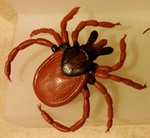
Country/State : Salt Lake City, UT
Age : 52
Joined : 2010-04-13
Posts : 6718
 |  Subject: Re: Mathison Museum of Natural History Subject: Re: Mathison Museum of Natural History  Fri Mar 15, 2024 11:42 am Fri Mar 15, 2024 11:42 am | |
| Species: † Pentecopterus decorahensis Lamsdell et al., 2015 About the Figure: Manufacturer: Paleo-Creatures Series: N/A Year of Production: 2016 Size/Scale: Body length (excluding appendages) approximately 7.2 cm for a scale of 1:10.4-1:13.8, or a possible maximum scale of 1:23.6 (see below) Frequency of species in toy/figure form (at time of posting): Unique Miscellaneous Notes: This model was made by forum member Jetoar. The eurypterid is removable from its base. The scale range of 1:10.4-1:13.8 above is based on an estimated body length of 75-100 cm based on limb specimens while the maximum scale of 1:23.6 is based on a possible maximum body length of 170 cm based on large tergite specimens. About the Organism: Geographic distribution: Middle Ordovician (Darriwilian) of present-day North America Habitat: Shallow marine or brackish waters Diet: Predaceous on soft-bodied animals IUCN Status (at time of posting): N/A [prehistoric] Miscellaneous Notes: The shale where P. decorahensis fossils were discovered contained few other marine animals. Researches have speculated that the habitat the eurypterid lived in might have been shallow, brackish water near shore that was low in oxygen and inhospitable to other marine taxa. [You must be registered and logged in to see this image.] |
|   | | bmathison1972

Country/State : Salt Lake City, UT
Age : 52
Joined : 2010-04-13
Posts : 6718
 |  Subject: Re: Mathison Museum of Natural History Subject: Re: Mathison Museum of Natural History  Sat Mar 16, 2024 1:07 pm Sat Mar 16, 2024 1:07 pm | |
| Species: Euderma maculatum (Allen, 1891) Common name(s): spotted bat About the Figure: Manufacturer: Play Visions Series: Bats Year of Production: 1996 Size/Scale: Wingspan 8.1 cm. Body length approximately 3.0 cm for a scale of 1:4 Frequency of species in toy/figure form (at time of posting): Unique Miscellaneous Notes: The 1996 Play Visions Bats collection features 6 species of bats, 4-6 of which are unique as toys and figures, depending on the species assigned to a couple of them. Four that are most certainly unique include the wrinkle-nosed bat, California leaf-nosed bat, Egyptian fruit bat, and today's spotted bat. There is also a horseshoe bat and vampire bat, both of which could represent more than one species. About the Organism: Geographic distribution: Western North America Habitat: Ponderosa pine forest, marshland, deserts, shrub-steppe, cliffs, agricultural land Diet: Flying insects IUCN Status (at time of posting): Least Concern Miscellaneous Notes: Euderma maculatum uses echolocation at very low frequencies (9-12 kHz). As such, it tends to specialize on larger insect prey, such as large moths and grasshoppers. [You must be registered and logged in to see this image.] |
|   | | Roger
Admin
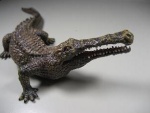
Country/State : Portugal
Age : 50
Joined : 2010-08-20
Posts : 35845
 |  Subject: Re: Mathison Museum of Natural History Subject: Re: Mathison Museum of Natural History  Sat Mar 16, 2024 1:34 pm Sat Mar 16, 2024 1:34 pm | |
| So you think the identification of the Play Visions as Rhinolophus ferrumequinum is as valid as any other. Bats are another group of very hard to identify animals since there are loads of species and most of them look alike. |
|   | | bmathison1972

Country/State : Salt Lake City, UT
Age : 52
Joined : 2010-04-13
Posts : 6718
 |  Subject: Re: Mathison Museum of Natural History Subject: Re: Mathison Museum of Natural History  Sat Mar 16, 2024 2:08 pm Sat Mar 16, 2024 2:08 pm | |
| - Roger wrote:
- So you think the identification of the Play Visions as Rhinolophus ferrumequinum is as valid as any other. Bats are another group of very hard to identify animals since there are loads of species and most of them look alike.
[You must be registered and logged in to see this link.] - for TAI you should probably keep it at the genus level. It's impossible to say from the figure. I am databasing mine as the lesser horseshoe bat (Rhinolophus hipposideros), only because I have a Kaiyodo figure representing the greater. |
|   | | bmathison1972

Country/State : Salt Lake City, UT
Age : 52
Joined : 2010-04-13
Posts : 6718
 |  Subject: Re: Mathison Museum of Natural History Subject: Re: Mathison Museum of Natural History  Sun Mar 17, 2024 1:57 pm Sun Mar 17, 2024 1:57 pm | |
| Species: Lucanus gamunus Sawada & Watanabe, 1960 About the Figure: Manufacturer: Kaiyodo Series: Choco Q Animatales Series 6; Choco-Q Animatales Be-Pal Special Edition Years of Production: 2002; 2003 Size/Scale: Body length (including mandibles) approximately 4.5 cm for a scale of 2:1-1.5.1 (see below) Frequency of species in toy/figure form (at time of posting): Very rare Miscellaneous Notes: The figure on the bottom/middle is from the 2002 Choco Q Animatales Series 6 collection. The other two figures are from the Be-Pal Special Edition collection which came out the following year. Figures in the Be-Pal collection represent repaints of the figures from the Choco Q Series 6 collection. Apparently, the figure with the bright yellow elytra was based on a specimen that was collected by the sculptor of the figure (Shinobu Matsumura) and this unusual morphotype reportedly 'shocked the stag beetle world'. Being original Choco Q figures, assembly is required. I had a difficult time finding information on the body length of the species and the scale above was calculated based on a body length of 2.3-3.0 cm which is based on specimens for purchase online. Looking at other photos online, I wouldn't be surprised if the figures were closer to 1:1 for a larger specimen. Other than these three figures, which all represent the same sculpt, the only other figure of this species I am aware of was produced by Sega. About the Organism: Geographic distribution: Japan (Izu Islands) Habitat: Broadleaf forests Diet: Presumably, larvae feed in rotting wood and detritus while adults feed on tree sap IUCN Status (at time of posting): Not Evaluated Miscellaneous Notes: I had a hard time finding any information on the size, biology, and distribution of this species. It appears to be endemic to the Izu Islands, including but probably not limited to, Mikura-jima and Kōzu-shima. [You must be registered and logged in to see this image.]
Last edited by bmathison1972 on Wed Mar 27, 2024 10:46 pm; edited 1 time in total |
|   | | widukind
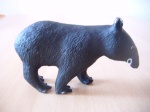
Country/State : Germany
Age : 48
Joined : 2010-12-30
Posts : 45779
 |  Subject: Re: Mathison Museum of Natural History Subject: Re: Mathison Museum of Natural History  Mon Mar 18, 2024 9:13 am Mon Mar 18, 2024 9:13 am | |
| |
|   | | bmathison1972

Country/State : Salt Lake City, UT
Age : 52
Joined : 2010-04-13
Posts : 6718
 |  Subject: Re: Mathison Museum of Natural History Subject: Re: Mathison Museum of Natural History  Mon Mar 18, 2024 11:36 am Mon Mar 18, 2024 11:36 am | |
| Species: Etmopterus granulosus (Günther, 1880) Common name(s): southern lanternshark About the Figure: Manufacturer: Discovery Communications Series: Return to the Isle of Jaws Year of Production: 2018 Size/Scale: Body length approximately 6.5 cm for a scale of 1:9.2-1:13.2 Frequency of species in toy/figure form (at time of posting): Very rare to unique depending on species assigned (see below) Miscellaneous Notes: Discovery didn't identify this figure at the species level, and with over 40 species in the genus Etmopterus, putting a species name on this figure would be challenging. My identification is based on that Discovery Channel featured E. granulosus in an episode of Shark Week in 2016, and in that same year Forbes did an online article featuring a lantern shark that showed the same image that was used on the packaging for this figure. About the Organism: Geographic distribution: Southern Pacific, Indian, and Atlantic Oceans Habitat: Pelagic; at depths of 220-1,620 meters (usual range 400-600 meters) Diet: Bony fish, marine invertebrates IUCN Status (at time of posting): Least Concern Miscellaneous Notes: Like other lantern sharks, E. granulosus is bioluminescent. Dorsal photophores, flank markings, and brighter pectoral fin and claspers are likely to be used for intraspecific communications and the ventrally emitted light is likely to be used for counter-illumination. [You must be registered and logged in to see this image.] |
|   | | widukind

Country/State : Germany
Age : 48
Joined : 2010-12-30
Posts : 45779
 |  Subject: Re: Mathison Museum of Natural History Subject: Re: Mathison Museum of Natural History  Mon Mar 18, 2024 5:34 pm Mon Mar 18, 2024 5:34 pm | |
| |
|   | | bmathison1972

Country/State : Salt Lake City, UT
Age : 52
Joined : 2010-04-13
Posts : 6718
 |  Subject: Re: Mathison Museum of Natural History Subject: Re: Mathison Museum of Natural History  Tue Mar 19, 2024 11:36 am Tue Mar 19, 2024 11:36 am | |
| Species: † Titanochelon bolivari (Hernandez-Pacheco, 1917) About the Figure: Manufacturer: Signatustudio Series: 1:20 Miocene Collection Year of Production: 2022 Size/Scale: Carapace length approximately 9.5 cm for a scale of 1:16-1:21 Frequency of species in toy/figure form (at time of posting): Unique Miscellaneous Notes: Most of the non-arthropod part of my collection is synoptic, so I don't have a lot to compare with this figure. However, the Colorata Aldabra giant tortoise and the CollectA 'Lonesome George' Pinta Island giant tortoise both scale with this model. The Schleich 2020 Galápagos tortoise might also scale well with it, depending what the species the collector chooses to have it represent. About the Organism: Geographic distribution: Miocene of the Iberian Peninsula Habitat: Open woodlands, woody grasslands Diet: Browser on low-growing vegetation IUCN Status (at time of posting): N/A [prehistoric] Miscellaneous Notes: Phylogenetic analyses place Titanochelon as being most-closely related to the African genus Stigmochelys, suggesting the genus has an African origin. There are 10 described species in the genus, plus several that remain undescribed. Fossils have been found through southern and central Europe dating from the early Miocene to the early Pleistocene. It is believed the genus became extinct early in the Pleistocene due to cooling brought on by glaciation. [You must be registered and logged in to see this image.] |
|   | | widukind

Country/State : Germany
Age : 48
Joined : 2010-12-30
Posts : 45779
 |  Subject: Re: Mathison Museum of Natural History Subject: Re: Mathison Museum of Natural History  Tue Mar 19, 2024 5:43 pm Tue Mar 19, 2024 5:43 pm | |
| |
|   | | bmathison1972

Country/State : Salt Lake City, UT
Age : 52
Joined : 2010-04-13
Posts : 6718
 |  Subject: Re: Mathison Museum of Natural History Subject: Re: Mathison Museum of Natural History  Wed Mar 20, 2024 11:47 am Wed Mar 20, 2024 11:47 am | |
| Species: Danaus plexippus (Linnaeus, 1758) Common name(s): monarch; milkweed butterfly About the Figure: Manufacturer: 4D Master Series: Bug & Creature World Year of Production: 2005 Size/Scale: Wingspan approximately 14.5 cm for a scale of 1.7:1-1.4:1 Frequency of species in toy/figure form (at time of posting): Common Miscellaneous Notes: This is the tenth time we have seen D. plexippus in the Museum. This is a puzzle figure and it comes in 26 pieces. According to the paperwork, one is a 'beginner' if they can assemble it in 13 minutes, 'average' if in 9 minutes, and 'advanced' if in 7 minutes. Despite the figure's size and quality, it has the common anatomical error of two many (six) function walking legs for a nymphalid. The same sculpt would be later used for other butterflies by 4D Master, including the Helena morpho, an 'eight-eight' butterfly, and Cairns birdwing. About the Organism: Geographic distribution: North, Central, and South America, the Caribbean, the Azores, Canary Islands, North Africa, Australia, Philippines, and South Pacific islands; rare stray to the United Kingdom Habitat: Fields, forests, parks, gardens, disturbed areas Diet: Larvae feed on milkweeds in the family Apocynaceae, especially members of the genus Asclepias; adults take nectar from a variety of flowers IUCN Status (at time of posting): Least Concern Miscellaneous Notes: Danaus plexippus exhibits Müllerian mimicry with the viceroy ( Limenitis archippus), whereby both species are distasteful to would-be predators; the latter can be distinguished by a black bar that runs along the lower portion of the hind wings. [You must be registered and logged in to see this image.] |
|   | | rogerpgvg
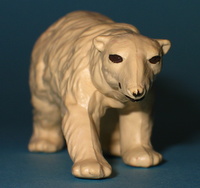
Country/State : UK
Age : 54
Joined : 2016-04-29
Posts : 3897
 |  Subject: Re: Mathison Museum of Natural History Subject: Re: Mathison Museum of Natural History  Wed Mar 20, 2024 1:10 pm Wed Mar 20, 2024 1:10 pm | |
| Beautifully made, it doesn't look like a puzzle model. |
|   | | widukind

Country/State : Germany
Age : 48
Joined : 2010-12-30
Posts : 45779
 |  Subject: Re: Mathison Museum of Natural History Subject: Re: Mathison Museum of Natural History  Wed Mar 20, 2024 5:36 pm Wed Mar 20, 2024 5:36 pm | |
| |
|   | | bmathison1972

Country/State : Salt Lake City, UT
Age : 52
Joined : 2010-04-13
Posts : 6718
 |  Subject: Re: Mathison Museum of Natural History Subject: Re: Mathison Museum of Natural History  Thu Mar 21, 2024 12:17 pm Thu Mar 21, 2024 12:17 pm | |
| Species: Vespula flaviceps (Smith, 1870) Common name(s): common Asian yellowjacket About the Figure: Manufacturer: Bandai Series: Diversity of Life on Earth - Hornets Vol. 1 Year of Production: 2020 Size/Scale: Wingspan (as displayed here) approximately 15.5 cm. Using forewing as a metric (n=6.7 cm) scale comes to 6.7:1-5.6:1 for a non-queen female specimen Frequency of species in toy/figure form (at time of posting): Very rare Miscellaneous Notes: Like other Diversity of Life on Earth figures, this was is large, requires assembly, and the final product is articulated. It is probably also expensive, especially now nearly four years after its release. It is a model for collectors and not a toy to be played with. The only other figure of this species I am aware of was produced by Break Co. Ltd., and that identification is my own. About the Organism: Geographic distribution: Central, East, and Southeast Asia, from Pakistan to East Russia, Indochina, and Japan Habitat: Forests, woodlands Diet: Larvae feed on insects provisioned by adults; adults feed on honeydew from sternorrhynchan insects and pollen from flowers IUCN Status (at time of posting): Not Evaluated Miscellaneous Notes: Vespula flaviceps is eaten as food in Japan. All developmental stages are eaten, but larvae are considered especially a delicacy. It can be cooked, fried, or pickled, and during some autumn festivals is served with rice. In the village of Kushihara, the people celebrate Hebo Matsuri on the third day of November, which is the world's largest wasp-eating festival! [You must be registered and logged in to see this image.] |
|   | | bmathison1972

Country/State : Salt Lake City, UT
Age : 52
Joined : 2010-04-13
Posts : 6718
 |  Subject: Re: Mathison Museum of Natural History Subject: Re: Mathison Museum of Natural History  Fri Mar 22, 2024 1:22 pm Fri Mar 22, 2024 1:22 pm | |
| Species: Mantis religiosa (Linnaeus, 1758) Common name(s): praying mantis; European mantis About the Figure: Manufacturer: Jasman Series: unknown Year of Production: unknown Size/Scale: Body length (including wings) approximately 24.0 cm for a scale of 4.8:1-3.2:1 Frequency of species in toy/figure form (at time of posting): Common Miscellaneous Notes: This is the fourth time we've seen M. religiosa in the Museum. I don't know much about this figure. Like most Jasman toys in my collection, I bought it randomly on eBay. It was probably produced in the 1990s. About the Organism: Geographic distribution: Southern Europe, Asia, North Africa; introduced to Australia and North America Habitat: Forests, grasslands, agricultural fields, disturbed areas, parks, gardens; usually in areas with shrubby vegetation Diet: Insects IUCN Status (at time of posting): Least Concern Miscellaneous Notes: Mantis religiosa does not engage in courtship displays. Males essentially 'ambush' females by sneaking up on them and jumping on their back. Once aboard, the male establishes a secure position using his raptorial front legs and his hind tibiae, the latter of which fit into grooves on either side of the female's mesothorax in front of her forewings. Mating takes about 4-5 hours, afterwhich the male detaches and then either drops the female to the ground (if on a branch, etc.) or leaves himself as quickly as possible, as females engage in sexual cannibalism. [You must be registered and logged in to see this image.] |
|   | | Kikimalou
Admin
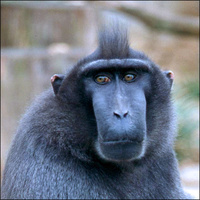
Country/State : Lille, FRANCE
Age : 60
Joined : 2010-04-01
Posts : 21185
 |  Subject: Re: Mathison Museum of Natural History Subject: Re: Mathison Museum of Natural History  Fri Mar 22, 2024 5:58 pm Fri Mar 22, 2024 5:58 pm | |
| - bmathison1972 wrote:
- Species: †Titanochelon bolivari (Hernandez-Pacheco, 1917)
About the Figure:
Manufacturer: Signatustudio
Series: 1:20 Miocene Collection
Year of Production: 2022
Size/Scale: Carapace length approximately 9.5 cm for a scale of 1:16-1:21
Frequency of species in toy/figure form (at time of posting): Unique
Miscellaneous Notes: Most of the non-arthropod part of my collection is synoptic, so I don't have a lot to compare with this figure. However, the Colorata Aldabra giant tortoise and the CollectA 'Lonesome George' Pinta Island giant tortoise both scale with this model. The Schleich 2020 Galápagos tortoise might also scale well with it, depending what the species the collector chooses to have it represent.
About the Organism:
Geographic distribution: Miocene of the Iberian Peninsula
Habitat: Open woodlands, woody grasslands
Diet: Browser on low-growing vegetation
IUCN Status (at time of posting): N/A [prehistoric]
Miscellaneous Notes: Phylogenetic analyses place Titanochelon as being most-closely related to the African genus Stigmochelys, suggesting the genus has an African origin. There are 10 described species in the genus, plus several that remain undescribed. Fossils have been found through southern and central Europe dating from the early Miocene to the early Pleistocene. It is believed the genus became extinct early in the Pleistocene due to cooling brought on by glaciation.
[You must be registered and logged in to see this image.] A wonderful model, must add it in 2024  |
|   | | widukind

Country/State : Germany
Age : 48
Joined : 2010-12-30
Posts : 45779
 |  Subject: Re: Mathison Museum of Natural History Subject: Re: Mathison Museum of Natural History  Fri Mar 22, 2024 6:44 pm Fri Mar 22, 2024 6:44 pm | |
| |
|   | | bmathison1972

Country/State : Salt Lake City, UT
Age : 52
Joined : 2010-04-13
Posts : 6718
 |  Subject: Re: Mathison Museum of Natural History Subject: Re: Mathison Museum of Natural History  Sat Mar 23, 2024 12:42 pm Sat Mar 23, 2024 12:42 pm | |
| Species: Coccinella septempunctata Linnaeus, 1758 Common name(s): seven-spotted lady beetle; seven-spot ladybird About the Figure: Manufacturer: Safari Ltd. Series: Safariology - Life Cycle of a Lady Bug Year of Production: 2013 Size/Scale: Body length of adult approximately 4.8 cm for a scale of 7.4:1-6.2:1 Frequency of species in toy/figure form (at time of posting): Common Miscellaneous Notes: This is the fifth time we've seen C. septempunctata in the Museum. Safari did not market these figures at the species level and the identification is my own based on the morphology of the adult. The scale above is based only on the adult. The larva looks like an early instar (although not specifically of C. septempunctata). About the Organism: Geographic distribution: Native to the Palearctic; adventive in North America and southern Africa Habitat: Forests, grasslands, marshes, deserts, agricultural fields, disturbed areas, parks, and gardens Diet: Soft-bodied insects, especially aphids and scale insects IUCN Status (at time of posting): Not Evaluated Miscellaneous Notes: Mating and egg-laying typically take place in the spring and early summer, although in some climates egg-laying might continue into early autumn. A female will lay 200-1,000 eggs over the course of a season. After emergence from the egg, a larva will remain with its egg casing, eat it, and eat any infertile eggs in the vicinity. As the larvae develop, they shift from sucking aphid liquids as meals to eating the entire insect. Coccinella septempunctata has four larval instars, the lengths of which are largely influenced by the abundance of aphids and temperature. Before pupation, the fourth instar will stop foraging for 24 hours and attach itself to a substrate with the tip of its abdomen. After emergence from the pupal casing, the young adult has very soft elytra that lack pigmentation and the characteristic coloration develops over time. [You must be registered and logged in to see this image.] |
|   | | bmathison1972

Country/State : Salt Lake City, UT
Age : 52
Joined : 2010-04-13
Posts : 6718
 |  Subject: Re: Mathison Museum of Natural History Subject: Re: Mathison Museum of Natural History  Sun Mar 24, 2024 12:13 pm Sun Mar 24, 2024 12:13 pm | |
| Species: Propylea japonica (Thunberg, 1781) About the Figure: Manufacturer: Stasto Series: 3D File - Ladybug Collection; 3D File - Ladybugs & Cetoniinae Years of Production: 2020; 2022 Size/Scale: Body length of black figure approximately 5.7 cm for a scale of 19:1-12.1:1; body length of black-and-yellow figure approximately 5.9 cm for a scale of 19.7:1-12.6:1 Frequency of species in toy/figure form (at time of posting): Very rare (unique as a pair) Miscellaneous Notes: The black figure was produced in 2020 for the 3D File Ladybug Collection; the black-and-yellow figure was produced in 2022 for the 3D File Ladybugs & Cetoniinae collection. Despite representing the same species, the two figures are not the exact same sculpt. Stasto 3D File figures have an ingenious design for distribution that minimizes packaging. There are usually eight figures in a collection. Two figures come connected to form their own gashapon capsule. The two figures are separated by gently twisting them. Once apart, the bottom of the figure extends, revealing the legs and antennae. The legs and antennae are extended and placed in the desired position and then the body is closed back up, revealing the final product. About the Organism: Geographic distribution: East and Southeast Asia, from India to Vietnam, Laos, China, Korean Peninsula, Japan Habitat: Forests, arable land, parks, gardens Diet: Adults and larvae are predaceous on soft-bodied insects, especially aphids, whiteflies, and small lepidopteran larvae IUCN Status (at time of posting): Not Evaluated Miscellaneous Notes: Propylea japonica is used in integrated pest management for the control of agricultural insect pests throughout East Asia. [You must be registered and logged in to see this image.] |
|   | | Joliezac
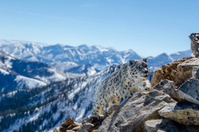
Country/State : New Jersey, USA
Age : 22
Joined : 2021-04-26
Posts : 2438
 |  Subject: Re: Mathison Museum of Natural History Subject: Re: Mathison Museum of Natural History  Sun Mar 24, 2024 3:04 pm Sun Mar 24, 2024 3:04 pm | |
|
Very nice figures!
_________________
Jolie
Animal Ark Website
Animal Figure Photography Website
|
|   | | widukind

Country/State : Germany
Age : 48
Joined : 2010-12-30
Posts : 45779
 |  Subject: Re: Mathison Museum of Natural History Subject: Re: Mathison Museum of Natural History  Mon Mar 25, 2024 9:32 am Mon Mar 25, 2024 9:32 am | |
| |
|   | | bmathison1972

Country/State : Salt Lake City, UT
Age : 52
Joined : 2010-04-13
Posts : 6718
 |  Subject: Re: Mathison Museum of Natural History Subject: Re: Mathison Museum of Natural History  Mon Mar 25, 2024 1:52 pm Mon Mar 25, 2024 1:52 pm | |
| Species: Callicaria superba (Mulsant, 1853) About the Figure: Manufacturer: Stasto Series: 3D File - Ladybugs & Scarabs Year of Production: 2021 Size/Scale: Body length approximately 5.5 cm for a scale of 5:1-4.6:1 Frequency of species in toy/figure form (at time of posting): Unique Miscellaneous Notes: Stasto 3D File figures have an ingenious design for distribution that minimizes packaging. There are usually eight figures in a collection. Two figures come connected to form their own gashapon capsule. The two figures are separated by gently twisting them. Once apart, the bottom of the figure extends, revealing the legs and antennae. The legs and antennae are extended and placed in the desired position and then the body is closed back up, revealing the final product. About the Organism: Geographic distribution: East Asia, from India to Taiwan and Japan Habitat: Forests, woodlands, agricultural fields Diet: Adults and larvae are predaceous on sternorrhynchan insects, particularly adelgids, aphids, and psyllids IUCN Status (at time of posting): Not Evaluated Miscellaneous Notes: Callicaria superba is one of the largest lady beetles in East Asia and is valued as predator of sternorrhynchan insects that infest forestry trees, orchard trees, cotton, and fruit and vegetable crops. [You must be registered and logged in to see this image.] |
|   | | widukind

Country/State : Germany
Age : 48
Joined : 2010-12-30
Posts : 45779
 |  Subject: Re: Mathison Museum of Natural History Subject: Re: Mathison Museum of Natural History  Mon Mar 25, 2024 5:57 pm Mon Mar 25, 2024 5:57 pm | |
| |
|   | | bmathison1972

Country/State : Salt Lake City, UT
Age : 52
Joined : 2010-04-13
Posts : 6718
 |  Subject: Re: Mathison Museum of Natural History Subject: Re: Mathison Museum of Natural History  Tue Mar 26, 2024 11:45 am Tue Mar 26, 2024 11:45 am | |
| Species: † Zuul crurivastator Arbour & Evans, 2017 About the Figure: Manufacturer: Safari Ltd. Series: Dino Dana Year of Production: 2022 Size/Scale: Body length approximately 19.0 cm for a scale of 1:32 (see below) Frequency of species in toy/figure form (at time of posting): Very rare Miscellaneous Notes: This was the first figure of this species, which was only described in 2017! In 2023, Kaiyodo produced a miniature (and it's skeleton). Also in late 2023, PNSO produced Zuul in the standard-sized range. While I am sure many would be quick to replace the Safari version with PNSO, I decided to keep the OG in my collection (especially since I tend to prefer Safari's style). The scale above was calculated based on an estimated size of 6.0 meters for the animal itself. Whether this figure represents the Keymaster or the Gatekeeper, is up to the collector (see below). About the Organism: Geographic distribution: Late Cretaceous (Campanian) of present-day North America Habitat: Temperate forests and associated riparian areas Diet: Browser on low vegetation IUCN Status (at time of posting): N/A [prehistoric] Miscellaneous Notes: In case this is not known to anyone in the dinosaur or dinosaur toy community, the genus Zuul was indeed named after the demon dogs from the Ghostbusters franchise. The species name comes from the Latin crus (shank or shin) and vastator (destroyer). So, while common names are not often used for dinosaurs as they are extant animals, one such option for this critter could be the Shin-crushing Demon Dog! [You must be registered and logged in to see this image.]P.S. As many of you know, I draw these daily posts from a database that has all figures alphabetical by genus and species, regardless of higher taxonomic rank. One might think ' Zuul' would be last on that list. Nope. I have one species, and one figure of that species, that alphabetically comes after Zuul :-). |
|   | | bmathison1972

Country/State : Salt Lake City, UT
Age : 52
Joined : 2010-04-13
Posts : 6718
 |  Subject: Re: Mathison Museum of Natural History Subject: Re: Mathison Museum of Natural History  Wed Mar 27, 2024 11:44 am Wed Mar 27, 2024 11:44 am | |
| Species: Papilio machaon Linnaeus, 1758 Common name(s): Old World swallowtail; common yellow swallowtail About the Figure: Manufacturer: Papo Series: Wild Animals/Garden Animals Year of Production: 2021 Size/Scale: Wingspan of adult approximately 6.5 cm for a scale of 1:1-1:1.2 (1:1 for a small specimen). Body length of larva approximately 4.7 cm, within scale 1:1. Frequency of species in toy/figure form (at time of posting): Uncommon Miscellaneous Notes: This is the fifth time we've seen P. machaon in the Museum. Both figures were produced in 2021, but independently and not part of a set or pair. In 2023, Papo moved several figures from their Wild Animals line to a new Garden Animals line, including both of these. About the Organism: Geographic distribution: Holarctic; widespread in boreal and temperate Eurasia and western North America Habitat: Highly varied, including forests, grasslands, hilltops, Alpine meadows, tundra, wetlands, disturbed areas, parks and gardens Diet: Larvae feed on primarily on plants in the families Apiaceae (umbillifers), but also Asteraceae (composites) and Rutaceae (rues); adults take nectar from flowers. IUCN Status (at time of posting): Least Concern [Europe] Miscellaneous Notes: The life cycle of P. machaon varies over its wide distribution. In many areas, it has 2-3 broods a year, but may only have one in northern areas. The caterpillar spends the first part of its life resembling a bird dropping, an effective defense against would-be predators. As the caterpillar grows larger, it takes on its green with black and orange markings. Like other Papilio species, larvae are equipped with an osmeterium, a fleshy, retractable organ that can release a foul smell when disturbed; the omseterium deters insects, but not birds. [You must be registered and logged in to see this image.] |
|   | | Sponsored content
 |  Subject: Re: Mathison Museum of Natural History Subject: Re: Mathison Museum of Natural History  | |
| |
|   | | | | Mathison Museum of Natural History |  |
|
Similar topics |  |
|
| | Permissions in this forum: | You cannot reply to topics in this forum
| |
| |
| |
